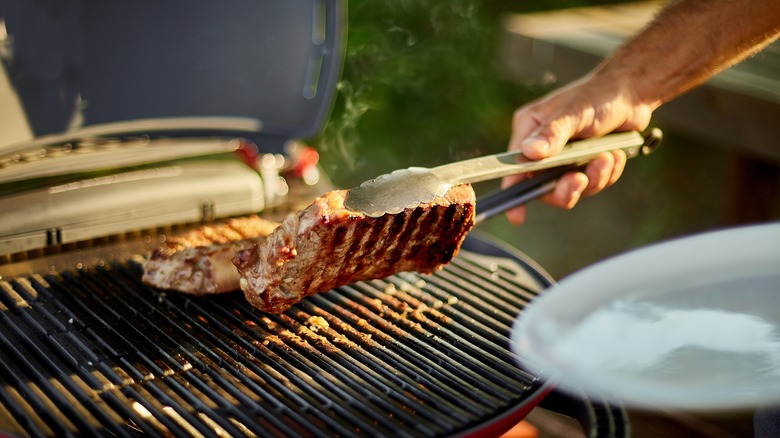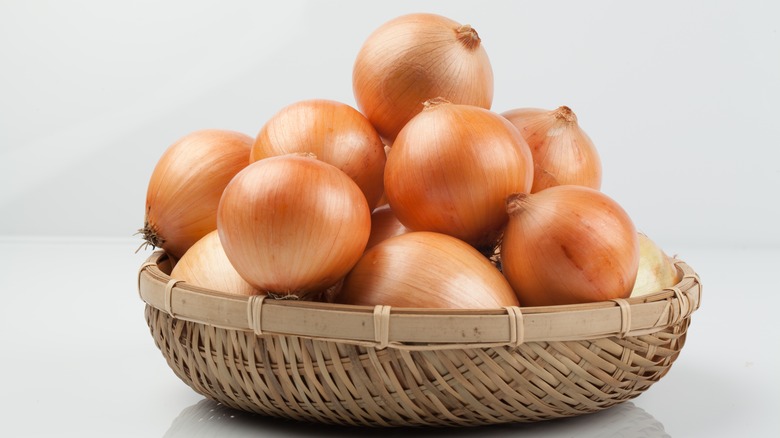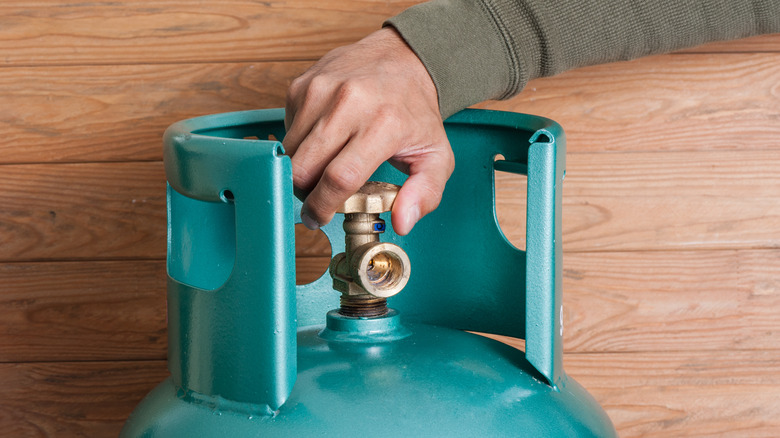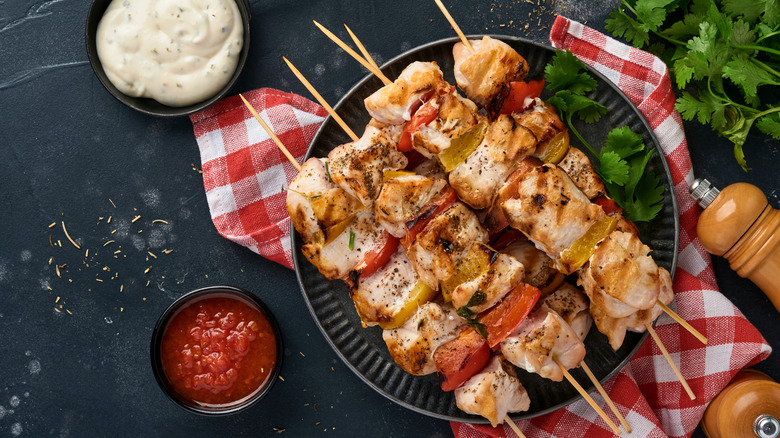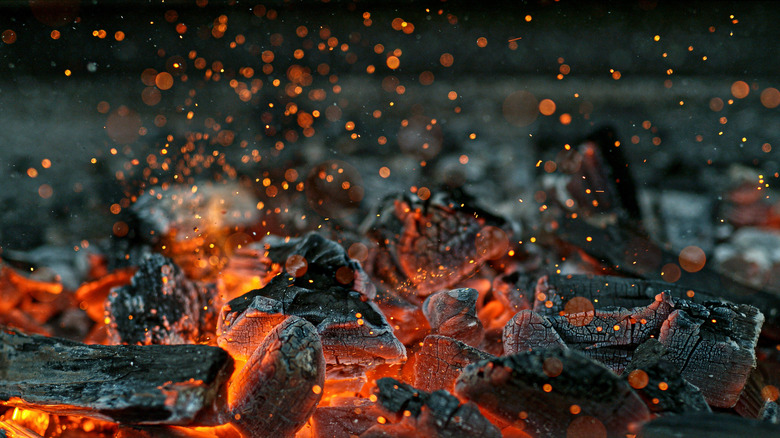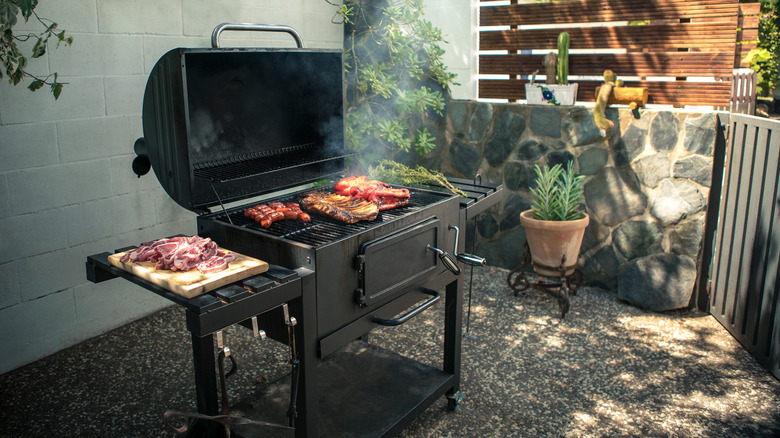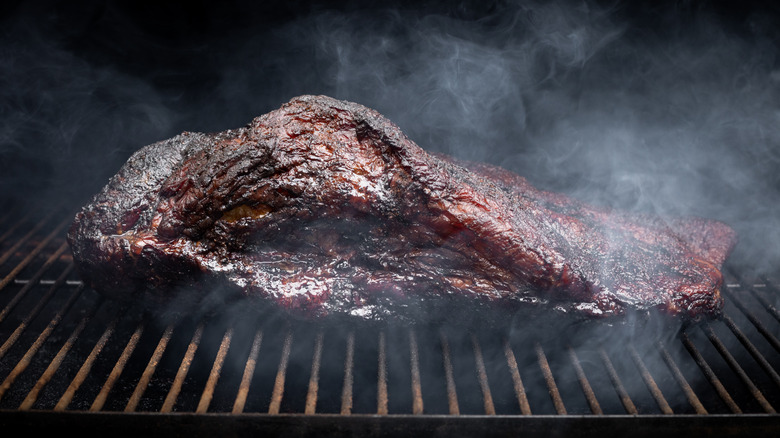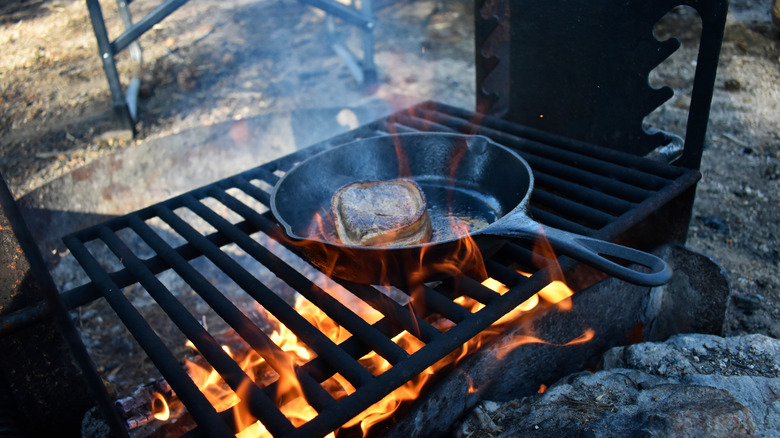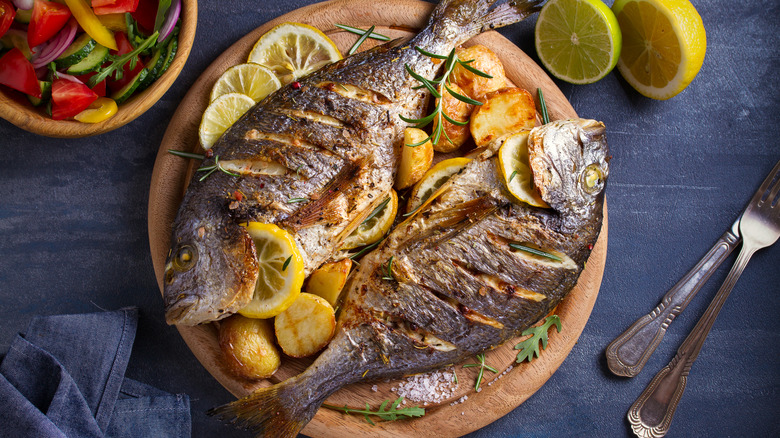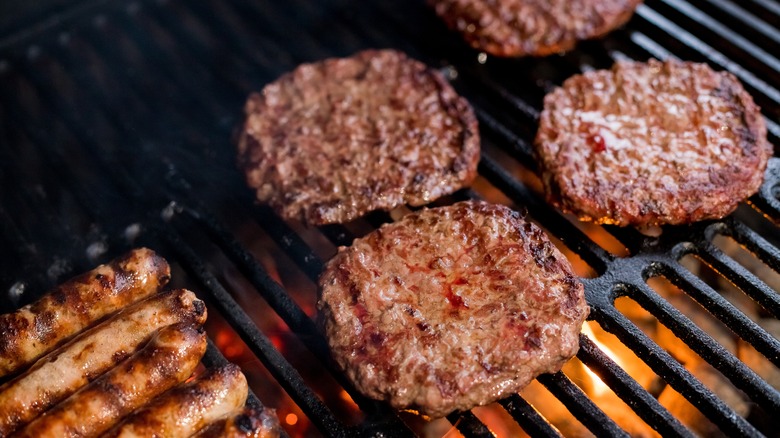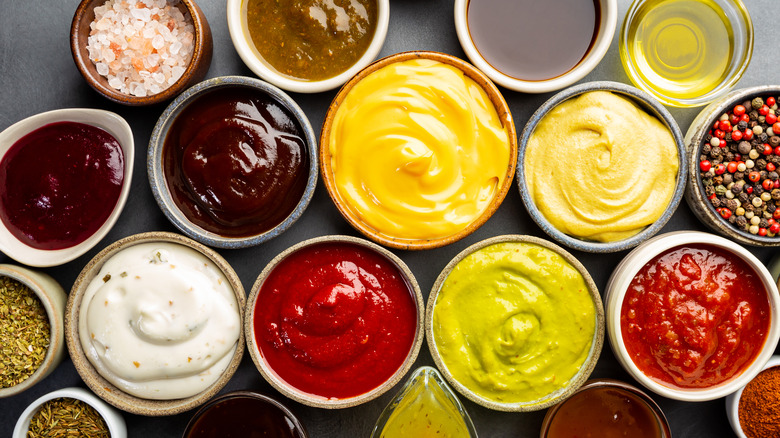Grilling Hacks You'll Wish You Knew Sooner
Summer is upon us, and your backyard grill is ready to get to work and provide some delicious eats for your friends and family all season long. Chances are, you've grilled plenty of hamburgers and hot dogs in your time, but your grill is capable of much more, such as other cuts of meat, pizza, and even fruit. No matter what you decide to toss on the grill this summer, the task is something that should be enjoyed, not dreaded.
Cooking for those you care about and sharing a heartfelt meal together is the perfect way to spend a sunny afternoon. There is nothing more communal than bonding over a feast, and preparing it for an appreciative crowd is enormously rewarding.
Grilling can be tricky, though. Heat levels aren't always easy to control, unexpected technical difficulties can arise, and the lack of certain equipment can put a damper on the experience. Whether you're a seasoned grill master looking to level up your skills or a grilling novice, here are some simple hacks that can make the experience both seamless and enjoyable.
Clean your grill with an onion
Before any food hits the heat, your grill must be as clean as possible. Cleaning your grill thoroughly is an important step to complete before lighting it. While store-bought cleaners may label themselves as "all purpose," the chemicals inside them have no place on the surface of what you will be using to cook food for your friends and family.
An easy, inexpensive, and efficient way to clean your grill is by using a halved onion. After heating up your grill and burning off any excess remains from its previous use, simply slice an onion in half, stab the outside of one of the halves with fork, and use the onion to scrape the grill grates. Not only do onions contain natural antibacterial properties, but you can also drop them into the coals post-cleaning to add some extra flavor later on. Now, you don't have to skimp on marinades or basting sauces. As long as you have an onion, you can have a grill clean enough to eat off of — literally.
Checking your propane level with warm water
Finding an empty propane tank after you've gathered all of your grilling ingredients and utensils is a barbecue worst-case scenario. Luckily, water is the only thing you need to check your propane levels ahead of time.
According to Ferrellgas, a quick and easy way to check your propane tank content is to pour warm water over the side of the tank. Then, run your finger downward against the tank. Once you have reached the cool spot, you have found your propane level. When the warm water comes into contact with the tank surface, it creates a reaction with its contents that causes the propane inside to cool down.
Although the warm water trick will not provide an exact reading of the amount of propane left inside, it will give you an idea of when you may have to go for a refill or an exchange. However, there are specific tools on the market that give an instant, exact reading of your propane tank level by measuring its internal pressure.
Soak your skewers
Kebabs are a delicious grilling option, and they're both versatile and easy to cook. There are a few tips for grilling your kebabs to their fullest, most tasty potential, such as keeping different types of meat separate because of their required internal temperatures, as well as separating meats from vegetables because of their completely different cooking times. Soaking your kebab skewers in water ahead of time, however, is a simple hack with a big payoff.
If you are using wooden skewers, soaking them in water for at least 30 minutes ahead of cooking will prevent them from burning on the grill. Although grilling kebabs is fairly straightforward, if your skewers catch fire, they'll subsequently burn whatever is on them. Even if they avoid catching fire, dry skewers can still burn and transfer that sooty, off-putting flavor to whatever you plan on eating. Soaking them in water is an easy, and quick task that will ensure the only thing being cooked is your food.
Light your coals with an egg carton
For those cooking on a charcoal grill, setting the fire itself can be challenging and time-consuming — and controlling the heat on the grill is even more so. It turns out empty cardboard egg cartons make for an excellent fire starter.
By simply filling the carton slots with pieces of charcoal and lighting the whole thing ablaze, you'll have an evenly heated and controlled base for your grill within seconds. Once you have your egg carton starter rolling, you can add extra coals to bring the grill up to temperature or disperse the heat as necessary.
Plus, this hack comes with more benefits than just convenience. Using a cardboard egg carton to light your coals eliminates the need for lighter fluid, which can transmit its not-so-tasty flavor onto the food you're cooking. Note: This hack should only be used with cardboard egg cartons and not styrofoam, as the burning of styrofoam releases toxic fumes that should not be inhaled, let alone absorbed by the food you're eating.
Indirect heat
Indirect heat is a great way to diversify what your grill is capable of at a given time. By keeping the temperature of the heat source the same throughout the grill, you limit what can be on the grill simultaneously as some items will finish cooking before or after others.
According to Food, Fire, Friends, indirect grilling involves concentrating the heat to the side of the meat versus directly underneath it. This works especially well with larger pieces of meat, and allows you to achieve deeper, richer flavors in addition to a dark, final sear at the end. Cooking with indirect heat essentially turns your charcoal or gas grill into a convection oven, allowing the meat on the grill to roast slowly and more evenly.
Plus, dispersing the heat into areas of different temperatures allows you to cook multiple things at once. While the meat is roasting on the cooler side, the side with the higher heat can be utilized to sear thinner pieces of meat or to cook vegetables. Per Food, Fire, Friends, cooking with indirect heat does require more attentiveness, but the versatility and enhanced final product make the extra surveillance well worth it.
Turn your grill into a smoker
Did you know you can also turn your grill into a smoker? Ribs, brisket, chicken, and a whole host of other ingredients can reach their maximum flavor potential by cooking them low-and-slow and full of smoke. Smokers are expensive, however, and purchasing one may not be the best option for those just wanting to try their hand at barbecue. There is, however, a simple way you can begin practicing your pit skills without a large monetary investment.
Known as the "snake method," arrange your coals in a semi-circle surrounding a pan of water that's at least half full. By placing wood on top of the "snake" of coals and lighting the ends of it, the temperature will slowly rise and facilitate the pan of water as the heat source. The water pan not only provides moisture inside the grill, it acts as a temperature regulator so you don't have to worry about the heat becoming too intense or dying out. As the wood on the snake burns, its smoke will fill the enclosed grill and impart all of its great flavor into the meat sitting inside.
This method also presents the opportunity to experiment with different types of wood to see which kinds work best for different meats. Your grill is already capable of a lot more than burgers and hot dogs — now it can venture into an entirely new and exciting world of backyard barbecue.
Grill with a cast iron skillet
Your cast iron skillet is a kitchen staple. Cast iron skillets have been used to cook meals for thousands of years and are capable of cooking just about anything. Their retention of heat, sturdiness, and durability make it a workhorse on your stovetop or in your oven, but the cast iron skillet's usefulness isn't limited to indoor cooking.
While cast iron skillets are an essential for open-fire cooking on a camping trip, they can also be utilized for your backyard grill. The steaks and burgers you normally sear on the grill grates can cook more evenly and are more easily controlled on a cast iron skillet. The fat left behind can be either saved or used to cook vegetables instead of dripping into the coals and burning.
Plus, vegetables or strips of bacon that can easily fall through the grates can be contained safely inside a cast iron skillet while accumulating the smoky flavors and aromas from the grill. Your grill can help get the most out of your cast iron skillet, and your cast iron skillet can help you get the most out of your grill.
Grill fish on a bed of citrus
Fish is an excellent choice for the grill. It's refreshing, light, and a great vehicle for marinades and a wide-range of seasonings. Cooking fish on the grill elevates it even further, stamping it with a crusty char and instilling it with that iconic smoky flavor and smell. The only problem is, fish is delicate and can tear easily. Beautifully cooking some fillets only to have them break apart and fall through the grates is nothing short of tragic. According to The Washington Post, however, you can remedy this problem with a few citrus slices — they'll help you grill fish with confidence as well as extra flavor.
Laying some thinly sliced lemon, lime, or orange on the grill will protect your fish fillets in addition to bringing some sharp, juicy flavors to the party. Afterward, the grilled citrus slices can be chopped up and added to a salsa or a vegetable medley as a vibrant, roasty flavor booster.
Keep burgers moist with an ice cube or butter
Dry burgers are disappointing. There's nothing better than a well-seasoned, evenly cooked, juicy patty. No matter what fixings top your burger, the overall taste of the dish relies on the meat itself. There are a variety of hacks that can help your burger retain its moisture, such as adding breadcrumbs to the meat mix or constantly basting the burgers with butter while they're on the grill. Tucking an ice cube into the middle of your burger patty is a simple hack that is accessible to everyone and actually works.
As the burger patty cooks on the grill, the melted ice cube is absorbed into the meat, preventing it from drying out. The only thing you need to be wary of is the size of the burgers and their target internal temperature. Patties that are too small will not completely envelop the ice cube causing it to melt off and rendering this hack useless. If you plan on cooking your burgers rare, the interior will not reach a temperature high enough to fully melt the ice cube, and it will be left behind cold and unmelted.
Serve condiments in a muffin tin
Once the burgers, hot dogs, and other meats you have cooked are ready to be enjoyed, the swarm of hungry family and friends racing for their plate can be made a lot more efficient with a regular muffin tin.
The plastic squirt bottles filled with ketchup, mustard, mayo, or any other condiment can become messy and are not very efficient. Filling each cup of a muffin tin with a different condiment and inserting a spoon for retrieval is a super simple and efficient way of making sure everyone gets the condiments they want without having to go searching or asking for them. This hack is also great for transporting condiments to a different location. If asked to attend a backyard cookout, bringing an assortment of condiments in a muffin tin is a considerate gesture that does not require a shopping bag full of bottles and jars.
